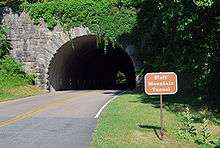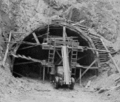Blue Ridge Parkway tunnels
 Bluff Mountain Tunnel | |
| Overview | |
|---|---|
| Location | Blue Ridge Parkway |
| Route | Blue Ridge Parkway |
| Operation | |
| Work begun | 1930s |
| Constructed | stone and concrete |
Blue Ridge Parkway tunnels consist of a total of 26 vehicle tunnels constructed along the 469 miles (755 km) of the Blue Ridge Parkway. One, the Bluff Mountain Tunnel,[1] is in Virginia and twenty-five are in North Carolina.[2]
The design standards specified a minimum impact on the land. The vehicle tunnels were often constructed to reduce excessive landscape scarring that open cuts would have produced. They are used in areas of steep terrain where ridges run perpendicular to the roadway alignment.
North Carolina's more rugged terrain required the majority of the tunnels. Most of the work on the tunnel digging was done by hand and provided by the Civilian Conservation Corps in the 1930s.[3] Little machinery was used with the intention of creating manual labor in depressed economic times. They did have for tunneling truck-mounted water-cooled compressed air drills called "Jumbos." After the initial holes were drilled into the substrata, dynamite was used for blasting away the rock.[4]
Concrete lining was done during construction due to tunnel cave-ins.[5] This concrete lining was first used in the Devil's Courthouse Tunnel. It was later discovered that it enhanced the interior lighting within the tunnel itself. Where done the lining covered about a quarter of the interior structure. An additional benefit was the elimination of moisture entering the tunnel. Moisture in the winter caused ice problems.[6]
The Pine Mountain Tunnel is the longest on the Parkway at 1,434 feet (437 m). Ferrin Knob Tunnel #1 is the first and longest of the triplet tunnels. The local people once referred to ferns as "ferrins." Ferrin Knob Tunnel #2 is located at milepost 401.3 and Ferrin Knob Tunnel #3 is located at milepost 401.5.
The distinctive stone masonry portals now on the parkway tunnels were generally not part of the original construction of the 1930s. They were added later.[7]
Tunnels
The tunnels are listed below by milepost, name, and length. The maximum height is in the center of the tunnel and the minimum height is at the edge stripe.
NOTE: This table contains data that is significantly different from that provided by the National Park Service on their Blue Ridge Parkway site. The differences are mostly in the tunnel lengths, but also some max/min tunnel heights. If you intend to drive the Parkway by motorhome, please refer to the NPS site for the correct tunnel data.[8]
| Milepost | Name of the tunnel | Length | Maximum Height | Minimum Height |
|---|---|---|---|---|
| 53.1 | Bluff Mountain Tunnel | 630 feet (192 m) | 19 feet 1 inch (5.8 m) | 13 feet 7 inches (4.1 m) |
| 333.4 | Little Switzerland Tunnel | 547 feet (167 m) | 19 feet 8 inches (6.0 m) | 14 feet 4 inches (4.4 m) |
| 336.4 | Wild Acres Tunnel | 240 feet (73 m) | 19 feet 10 inches (6.0 m) | 13 feet 1 inch (4.0 m) |
| 344.6 | Twin Tunnel #1 North | 240 feet (73 m) | 21 feet (6.4 m) | 16 feet (4.9 m) |
| 344.7 | Twin Tunnel #2 South | 409 feet (125 m) | 19 feet 7 inches (6.0 m) | 14 feet 7 inches (4.4 m) |
| 349.0 | Rough Ridge Tunnel | 245 feet (75 m) | 21 feet 6 inches (6.6 m) | 13 feet 9 inches (4.2 m) |
| 364.4 | Craggy Pinnacle Tunnel | 176 feet (54 m) | 19 feet 9 inches (6.0 m) | 14 feet 1 inch (4.3 m) |
| 365.6 | Craggy Flats Tunnel | 335 feet (102 m) | 19 feet 5 inches (5.9 m) | 14 feet 1 inch (4.3 m) |
| 374.4 | Tanbark Ridge Tunnel | 746 feet (227 m) | 19 feet 5 inches (5.9 m) | 14 feet 1 inch (4.3 m) |
| 397.1 | Grassy Knob Tunnel | 600 feet (183 m) | 19 feet 2 inches (5.8 m) | 13 feet 7 inches (4.1 m) |
| 399.3 | Pine Mountain Tunnel | 1,320 feet (402 m) | 19 feet 3 inches (5.9 m) | 14 feet 2 inches (4.3 m) |
| 400.9 | Ferrin Knob Tunnel #1 | 360 feet (110 m) | 19 feet 6 inches (5.9 m) | 14 feet 2 inches (4.3 m) |
| 401.3 | Ferrin Knob Tunnel #2 | 231 feet (70 m) | 19 feet 2 inches (5.8 m) | 14 feet (4.3 m) |
| 401.5 | Ferrin Knob Tunnel #3 | 323 feet (98 m) | 19 feet 5 inches (5.9 m) | 13 feet 9 inches (4.2 m) |
| 403.0 | Young Pisgah Ridge Tunnel | 400 feet (122 m) | 19 feet 8 inches (6.0 m) | 14 feet 6 inches (4.4 m) |
| 403.9 | Fork Mountain Tunnel | 350 feet (107 m) | 19 feet 2 inches (5.8 m) | 14 feet 6 inches (4.4 m) |
| 406.9 | Little Pisgah Tunnel | 500 feet (152 m) | 19 feet 5 inches (5.9 m) | 13 feet 10 inches (4.2 m) |
| 407.4 | Buck Springs Tunnel | 380 feet (116 m) | 19 feet 2 inches (5.8 m) | 13 feet 8 inches (4.2 m) |
| 410.1 | Frying Pan Tunnel | 275 feet (84 m) | 19 feet 9 inches (6.0 m) | 13 feet 8 inches (4.2 m) |
| 422.1 | Devil's Courthouse Tunnel | 350 feet (107 m) | 19 feet (5.8 m) | 14 feet 2 inches (4.3 m) |
| 439.7 | Pinnacle Ridge | 750 feet (229 m) | 19 feet 1 inch (5.8 m) | 13 feet 10 inches (4.2 m) |
| 458.8 | Lickstone Ridge Tunnel | 402 feet (123 m) | 13 feet 1 inch (4.0 m) | 11 feet 1 inch (3.4 m) |
| 459.3 | Bunches Bald Tunnel | 268 feet (82 m) | 13 feet 4 inches (4.1 m) | 10 feet 6 inches (3.2 m) |
| 461.2 | Big Witch Tunnel | 348 feet (106 m) | 18 feet 1 inch (5.5 m) | 11 feet 3 inches (3.4 m) |
| 465.6 | Rattlesnake Mountain Tunnel | 410 feet (125 m) | 19 feet 6 inches (5.9 m) | 14 feet 5 inches (4.4 m) |
| 466.3 | Sherril Cove No. 6 Tunnel | 572 feet (174 m) | 19 feet 7 inches (6.0 m) | 14 feet 4 inches (4.4 m) |
Gallery
-

Tunnel construction 1930s
-

Bluff Mountain Tunnel
-

Craggy Flats Tunnel
-

Devil's Courthouse Tunnel
-

Young Pisgah Ridge Tunnel
-

Fryingpan Tunnel
-

Craggy Pinnacle Tunnel
-

Twin Tunnels
-

Grassy Knob Tunnel
-

Bunche's Bald Tunnel
-

Rattlesnake Mountain Tunnel
-

Little Switzerland Tunnel
-

Rough Ridge Tunnel
See also
![]() North Carolina portal
North Carolina portal
![]() U.S. Roads portal
U.S. Roads portal
![]() Virginia portal
Virginia portal
References
- ↑ Blue Ridge Parkway North
- ↑ Virtual Blue Ridge tunnels
- ↑ Blue Ridge Parkway history
- ↑ Blue Ridge Parkway tunnels Archived October 24, 2012, at the Wayback Machine.
- ↑ Blue Ridge Parkway Tunnels Archived September 7, 2008, at the Wayback Machine.
- ↑ Historic American Engineering Record, National Park Service, Jennifer K. Cuthbertson, 1997 (Sheet 1 of 28) and Lia M. Dikigoropoulou, 1997, (Sheet 24 of 28).
- ↑ Blue Ridge tunnels - National Park Service
- ↑ http://www.nps.gov/blri/planyourvisit/tunnel-heights.htm
Location
- Google maps location of Bluff Mountain Tunnel
- Google maps location of Little Switzerland Tunnel
- Google maps location of the 3 Ferrin Knob Tunnels
- Google maps location of Rattlesnake Mountain Tunnel
Coordinates: 35°51′13″N 82°05′49″W / 35.85348°N 82.09696°W